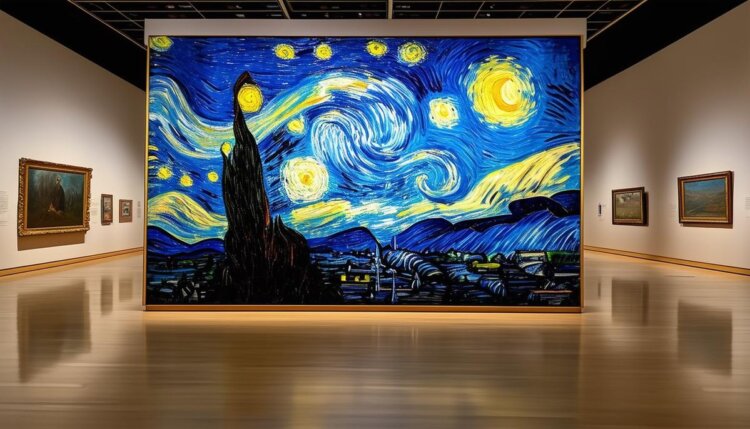The Creation of The Starry Night
Vincent van Gogh painted The Starry Night during his stay at the Saint-Rémy-de-Provence asylum in 1889. The view from his barred bedroom window influenced the painting, combining reality with Van Gogh's imagination. Despite his mental health challenges, the asylum provided him with a studio where he created over one hundred paintings.
The Starry Night showcases Van Gogh's bold use of color and thick paint application, or impasto. The swirling night sky, bright stars, and calm village below create a sense of movement and mysticism. Van Gogh's fascination with night landscapes is evident in the painting's vibrant blues and yellows, contrasting the bright celestial objects against a turbulent sky.
Van Gogh's expressive style, developed during his time in Paris, is apparent in the energetic brushstrokes that bring life to the canvas. Although he considered the painting a failure, it is this emotional charge that makes The Starry Night one of his most celebrated works.
His stay at the asylum wasn't just about isolation, but also about reflection and creation under new constraints. The view he captured went beyond the barred windows, bringing a sense of beauty amidst personal chaos.
Artistic Interpretations and Techniques
The Starry Night's swirling sky is its most iconic feature. Van Gogh's thick, undulating brushstrokes bring the night to life, embodying a sense of fluidity and movement. His intense color palette of blues, yellows, and whites creates a dynamic contrast that emphasizes the stars and moon against the brooding sky.
Van Gogh's impasto technique adds texture to the painting, enhancing the luminosity of the stars and giving a three-dimensional quality to the clouds and celestial swirls. This method amplifies the painting's sense of immediacy, as if the cosmos is in perpetual motion.
The village below, rendered with more controlled lines, contrasts with the vibrant sky above. This juxtaposition of tranquility and turbulence reflects Van Gogh's own search for peace amid mental turmoil. The looming cypress tree, traditionally associated with mourning, bridges the terrestrial and celestial worlds.
Key Elements of Van Gogh's Technique:
- Bold use of color
- Dynamic brushstrokes
- Impasto technique for texture
- Contrast between calm village and turbulent sky
Van Gogh's post-impressionist style moves beyond mere representation to convey his perspective and emotional state. His approach was revolutionary, abandoning realism for a more subjective, evocative style. This wasn't just about aesthetics but deeply tied to his experiences and mindset.
The Starry Night remains a testament to the power of artistic expression in conveying complex inner experiences. Its interplay of technique and emotion continues to resonate with audiences over a century later.
Legacy and Impact of The Starry Night
The Starry Night has had a profound impact on art and culture, despite Van Gogh's initial ambivalence about the work. He and his brother Theo regarded it as somewhat of a failure, favoring style over substance. However, over time, the painting has ascended to a revered status in the art world.
The painting's inclusion in the Museum of Modern Art (MoMA) collection in 1941 marked the beginning of its rise to fame. It has since become not only a centerpiece of MoMA's collection but an iconic representation of Van Gogh's genius.
"Looking at the stars always makes me dream," Van Gogh once said, "Why, I ask myself, shouldn't the shining dots of the sky be as accessible as the black dots on the map of France?"
In contemporary culture, The Starry Night transcends traditional art appreciation. Its image has been reinterpreted through various media, from digital art to merchandise, underscoring its universal appeal. It has also permeated popular culture, appearing in literature, music, and film, often symbolizing both the beauty and tumult of the human condition.
The painting's influence is evident in the work of many contemporary artists who draw inspiration from Van Gogh's techniques and emotional intensity. Its pioneering use of bold colors and dynamic brushstrokes has inspired modern art movements that emphasize subjective experience and emotional expression.
The Starry Night's enduring appeal lies in its ability to convey complex emotions through striking visual elements. It captures a sense of awe and contemplation that is universally relatable. This emotional accessibility, combined with Van Gogh's unique technique, ensures that The Starry Night remains a timeless masterpiece that continues to inspire and move audiences worldwide.
- Van Gogh V. The Letters of Vincent van Gogh. London: Penguin Classics; 2003.
- Soth L. Van Gogh's Agony. The Art Bulletin. 1986;68(2):301-313.
- Naifeh S, Smith GW. Van Gogh: The Life. New York: Random House; 2011.






















